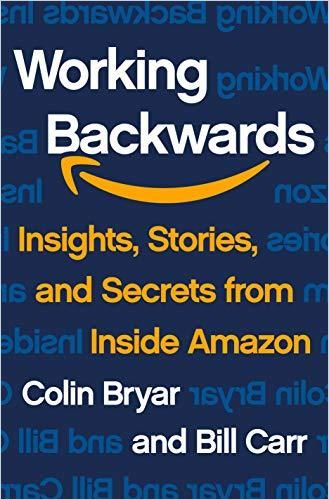Amazon insiders Colin Bryar and Bill Carr detail Amazon’s processes for hiring, compensation and expansion as well as using metrics, generating new ideas and nurturing its corporate culture.

How Amazon Does It
Amazon insider Colin Bryar became Jeff Bezos’ personal technical advisor and “shadow,” while co-author Bill Carr helped build Amazon’s digital products, including Prime and Amazon Web Services. Here, they detail Amazon’s principles, mechanisms and processes. While offering no criticism of Amazon, the authors provide insights about its processes and ideas that might help fuel your organization’s success.
Guiding Fundamentals
Amazon under-promises and over-delivers for its customers. It rejects short-term gains if they come at the expense of long-term value-building. It embraces experimentation, whatever the cost or size of previous failures. And Amazon takes pride in execution.
In 2015 Amazon became the company that reached $100 billion in annual sales faster than any other in the world.Colin Bryar and Bill Carr
In 1995, Jeff Bezos launched Amazon, and it grew from a handful of employees when it started to more than 500 by 1997. He focused funding and attention on creating a perfect customer experience.
Amazon’s principles have always informed its actions, including hiring decisions and new employee onboarding.The company’s guiding fundamentals drive every meeting, customer interaction, performance discussion and business decision.
Amazon Leadership Principles
In 2004, amid explosive growth, Amazon built a leadership development program. The program’s designers worked to understand and describe what first-rate leadership entails at Amazon. By 2005, Bezos approved a formal, but not final, list of leadership principles.
If a company’s principles must be memorized, it’s a warning sign that they aren’t sufficiently woven into the fabric of that company. Colin Bryar and Bill Carr
At Amazon, the authors write, the customer’s perspective matters most. People at Amazon learn to prioritize the needs of the entire company in order to avoid silos. The rules include: Always simplify and innovate. Select and groom smart, disciplined leaders. Never stop learning. Hire even better people. Coach, develop and guide team members. Continually meet and exceed top standards. Make bigger, bolder plans. Take risks and make educated, fast decisions. Spend wisely. Listen, show respect and admit your mistakes. Know the details of the business. Take on any task, large or small. Respectfully challenge others. Focus on outcomes.
Actions and Decisions
Amazon invests in a months-long process of annual planning that calls on every manager to establish expectations and metrics for the upcoming year.
No matter how clear your leadership principles and yearly plan may be, they speak softly in comparison to financial incentives. Colin Bryar and Bill Carr
The company sets goals at its most senior level – the Amazon S-Team. Bezos – who was succeeded in 2021 by current CEO Andy Jassy – and senior executives choose goals based on the results of the annual planning process. The S-Team attaches aggressive metrics to these goals, even while accepting that the firm will fail to achieve at least a quarter of them.
Executives build personal wealth at Amazon by focusing on the long term. Their bonuses, raises and rewards come in the form of stock, which aligns their interests with those of shareholders, the firm and its customers.
Hiring
Amazon grew from a few hundred people in 1997 to 100,000 people by 2013, so the company had to devise a replicable, repeatable process – the “Bar Raiser” – to fulfill its goal of making sure every new hire is better than the person who held the position previously.
Detailed job descriptions accompany every search, and hiring interviewers receive rigorous training. Once candidates are screened, they participate in a one-hour phone interview. About 25% move on to an additional five to seven in-person interviews. Interviewers rate candidates independently and then meet to discuss their evaluations. Interviewers, the hiring manager and the designated Bar Raiser must approve a hire together.
PowerPoint
Bezos believes PowerPoint allows presenters to gloss over details and distract or confuse decision-makers. Instead, Amazon uses Microsoft Word for presentations. That preference spawned the “Amazon Six-Pager.” When people want to present an idea or proposal to the S-Team, they must provide a structured, six-page description.
Amazon relies far more on the written word to develop and communicate ideas than most companies, and this difference makes for a huge competitive advantage. Colin Bryar and Bill Carr
A Six-Pager sets out the reasons for the idea or proposal and a profit and loss projection. It includes an attached FAQ. Decision makers read the Six-Pagers at the same time and then discuss them.
The Customer Perspective
Those who want to propose a new product also write a hypothetical press release and FAQ about it. This process is called: “Working Backwards.”
Most of Amazon’s major products and initiatives since 2004 have one very Amazonian thing in common — they were created through a process called Working Backwards. Colin Bryar and Bill Carr
The mock press release and FAQ lay out the basic facts and potential risks of the product. Then, the product’s champions must convince decision-makers that it fills a need by offering either a fresh concept or a vast improvement over a current product. Statements about new products go through several iterations as they survive a series of meetings with senior leaders.
The FAQ provides answers about the type and size of the market for the product, its potential price points and profit margins, and challenges or dependencies that might impede its development or limit demand.
Metrics
Rather than focus on output metrics, such as share price, Amazon prioritizes the input metrics” that drive share price and other outcomes.
The right input metrics get the entire organization focused on the things that matter most. Finding exactly the right one is an iterative process that needs to happen with every input metric. Colin Bryar and Bill Carr
To report and work with metrics in Weekly Business Review meetings, Amazonians use the Six Sigma method, DMAIC: Define, measure, analyze, improve and control. For example, they define and describe the scope of products available, their readiness for shipment, and their costs and prices; then they assess and analyze the overall package seeking areas of improvement and outlining a management path.
These inputs power Amazon’s virtuous cycle, in which improvements in one area are meant to accelerate a flywheel of growth in other areas. For example, Amazon Prime leveraged the flywheel by eliminating shipping charges for Amazon’s best customers, thus increasing sales, attracting more vendors, and providing more selections, which made customers happier, even though they paid for Prime, and continued to boost sales.
Amazon asks “why” repeatedly to get to the root of the problems or opportunities its metrics and measures reveal. Data and metrics, as well as instinct and experience, drive Amazon’s decisions.
All Good
You can find two types of books about Amazon. One kind says it’s totally evil and here’s why. The other kind says it’s totally great and here’s why. Colin Bryar and Bill Carr’s report falls avidly into the second camp. This springs from their insider perspective. Clearly, they love Amazon and, apparently, every method it employs. The authors know and understand those tactics from decades of experience and outline them in detail, so students, entrepreneurs, customers and businesspeople can understand and appreciate Amazon’s approaches – and even modify them to support their particular concerns. If you’re looking for warts-and-all coverage, you won’t find it here. Instead, this is an informed and useful account of how Amazon gets things done,







